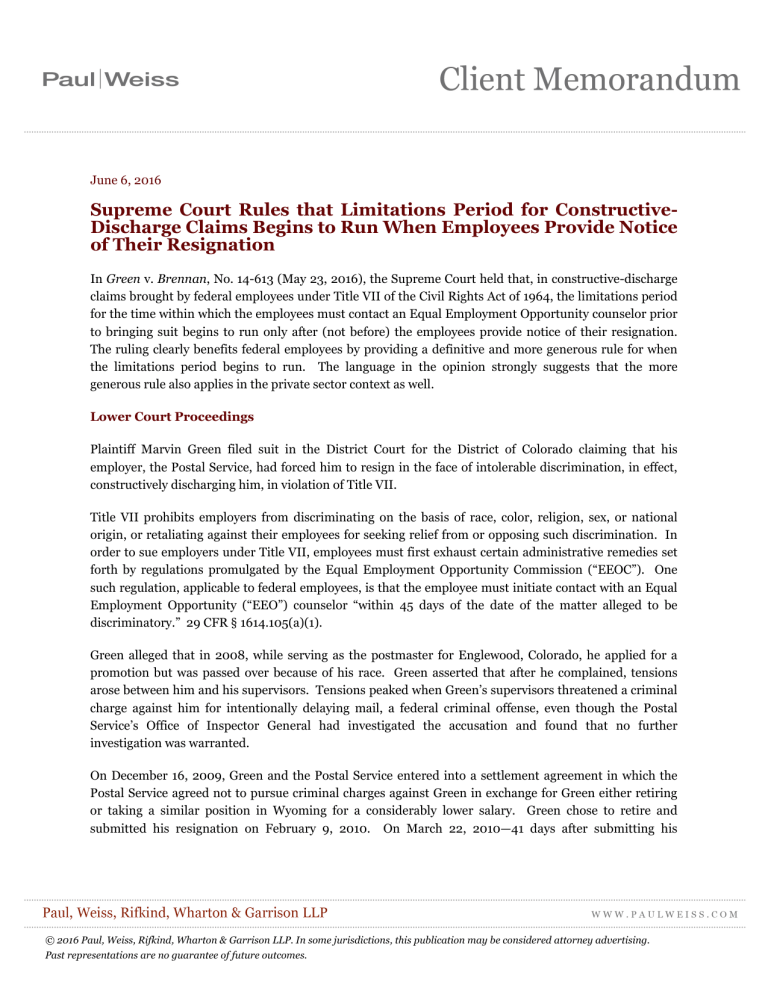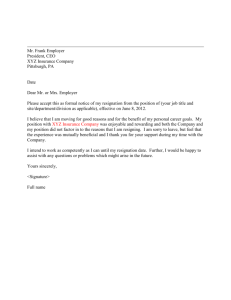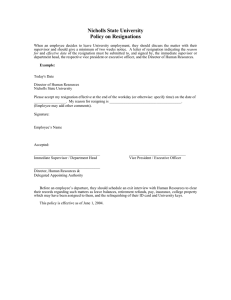PDF - Paul, Weiss

June 6, 2016
Supreme Court Rules that Limitations Period for Constructive-
Discharge Claims Begins to Run When Employees Provide Notice of Their Resignation
In Green v. Brennan , No. 14-613 (May 23, 2016), the Supreme Court held that, in constructive-discharge claims brought by federal employees under Title VII of the Civil Rights Act of 1964, the limitations period for the time within which the employees must contact an Equal Employment Opportunity counselor prior to bringing suit begins to run only after (not before) the employees provide notice of their resignation.
The ruling clearly benefits federal employees by providing a definitive and more generous rule for when the limitations period begins to run. The language in the opinion strongly suggests that the more generous rule also applies in the private sector context as well.
Lower Court Proceedings
Plaintiff Marvin Green filed suit in the District Court for the District of Colorado claiming that his employer, the Postal Service, had forced him to resign in the face of intolerable discrimination, in effect, constructively discharging him, in violation of Title VII.
Title VII prohibits employers from discriminating on the basis of race, color, religion, sex, or national origin, or retaliating against their employees for seeking relief from or opposing such discrimination. In order to sue employers under Title VII, employees must first exhaust certain administrative remedies set forth by regulations promulgated by the Equal Employment Opportunity Commission (“EEOC”). One such regulation, applicable to federal employees, is that the employee must initiate contact with an Equal
Employment Opportunity (“EEO”) counselor “within 45 days of the date of the matter alleged to be discriminatory.” 29 CFR § 1614.105(a)(1).
Green alleged that in 2008, while serving as the postmaster for Englewood, Colorado, he applied for a promotion but was passed over because of his race. Green asserted that after he complained, tensions arose between him and his supervisors. Tensions peaked when Green’s supervisors threatened a criminal charge against him for intentionally delaying mail, a federal criminal offense, even though the Postal
Service’s Office of Inspector General had investigated the accusation and found that no further investigation was warranted.
On December 16, 2009, Green and the Postal Service entered into a settlement agreement in which the
Postal Service agreed not to pursue criminal charges against Green in exchange for Green either retiring or taking a similar position in Wyoming for a considerably lower salary. Green chose to retire and submitted his resignation on February 9, 2010. On March 22, 2010—41 days after submitting his
© 2016 Paul, Weiss, Rifkind, Wharton & Garrison LLP. In some jurisdictions, this publication may be considered attorney advertising.
Past representations are no guarantee of future outcomes.
resignation but 96 days after signing the settlement agreement—Green contacted an EEO counselor to assert his allegedly unlawful constructive discharge.
The District Court dismissed the action as untimely because Green had failed to contact the EEO counselor within 45 days of the signing of the settlement agreement, which the District Court considered to be the date of the “matter alleged to be discriminatory.” The Tenth Circuit affirmed, holding that the
“matter alleged to be discriminatory” encompassed only the Postal Service’s discriminatory actions and not Green’s independent decision to resign. Thus, the Tenth Circuit explained, the limitations period for
Green to contact an EEO counselor began on December 16 and had long run by the time he contacted
EEO on March 22. Green v. Donahue , 760 F. 3d 1135 (2015).
The Supreme Court’s Grant of Certiorari and Decision
The Supreme Court granted certiorari to resolve a split in circuit court decisions on the issue of whether the limitations period for a constructive-discharge claim begins to run after the employer’s last discriminatory act or after the employee resigns.
In an opinion written by Justice Sotomayor and joined by five justices, the Supreme Court reversed and held that the limitations period under § 1615.105 (the regulation applicable to federal employees) for a constructive-discharge claim only begins to run after an employee resigns, because the “matter alleged to be discriminatory” includes all the elements that make up a constructive-discharge claim, including an employee’s resignation.
Because the text of the regulation itself does not inform what the phrase “matter alleged to be discriminatory” means with respect to a constructive-discharge claim, the Court applied the default
“standard rule” for limitations periods. The standard rule provides that ordinarily a “limitations period commences when the plaintiff has a complete and present cause of action,” which occurs when “the plaintiff can file suit and obtain relief.” On this basis, the Court held that the limitations period for
Green’s claim began when he resigned. The Court reasoned that an essential element of a constructivedischarge claim is that the employee must have actually resigned. Thus, because the claim can only be brought after resignation, a “complete and present cause of action” for a constructive-discharge claim only exists upon an employee’s resignation. Therefore, the resignation is the triggering event for the limitations period to commence. The Court also ruled that the date of an employee’s resignation for the purpose of the limitations period is the date on which the employee provides notice to his employer of his resignation.
Justice Thomas dissented, arguing that the standard rule for limitations periods is inapplicable here because the ordinary meaning of the phrase “matter alleged to be discriminatory” is clear and refers to the employer’s discriminatory acts that causes the employee’s resignation, not the employee’s resignation itself.
Interestingly, while Justice Alito also believed that the limitations period begins to run upon the discriminatory acts of the employer, he nevertheless concurred with the judgment because he believed that in cases such as this one, where Plaintiff presented sufficient evidence of the employer’s intent to force an employee to resign, the employee’s resignation could be considered a discriminatory act by the employer.
Analysis
The Supreme Court’s ruling provides for a definitive and more expansive rule as to when the limitations period begins to run for constructive-discharge actions brought by federal employees, since an employee’s resignation will necessarily come after the discriminatory acts that allegedly forced the employee’s resignation.
The ruling is also significant because the language of the opinion strongly suggests that the ruling will also apply to private-sector employees. As a threshold matter, in its grant of certiorari, the Court pointed to cases primarily involving private-sector employees as illustrations of the split in circuit court decisions. In the majority opinion interpreting the EEOC regulation applicable to federal employees, the Court also noted the statutory analogue for private-sector employees, which requires them to file a charge with the
EEOC within 180 or 300 days after “the alleged unlawful employment practice occurred.” Although the language for the limitations period is different, the Court observed that the EEOC treats the federal and private-sector employee limitations period as identical in operation. And in his concurrence, Justice
Alito, noting these points, expressed his belief that the majority thought that its decision applied both to the public and private sectors.
Thus, private sector plaintiffs bringing constructive-discharge claims will almost certainly argue that the
Green decision applies equally to their claims. The overall result of the Green ruling may be that all employers—private and public—may face the longer limitations period and have a more difficult time obtaining dismissals of constructive-discharge claims based on timeliness grounds in the future.
* * *
This memorandum is not intended to provide legal advice, and no legal or business decision should be based on its content. Questions concerning issues addressed in this memorandum should be directed to:
Allan J. Arffa
212-373-3203 aarffa@paulweiss.com
Robert A. Atkins
212-373-3183 ratkins@paulweiss.com
Jay Cohen
212-373-3163 jaycohen@paulweiss.com
Eric Alan Stone
212-373-3326 estone@paulweiss.com
Maria Helen Keane
212-373-3202 mkeane@paulweiss.com
Daniel J. Toal
212-373-3869 dtoal@paulweiss.com
Liza Velazquez
212-373-3096 lvelazquez@paulweiss.com
Associate Lin Ting Li contributed to this client alert.

